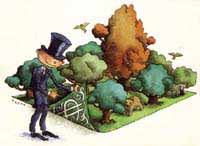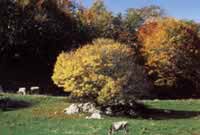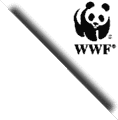|
 A
national park, a natural protected area may represent a new
approach with the natural heritage, with the landscape
and the area: no looting or devastation of the environment any longer,
but a rational use of the resources
through effective planning tools. A
national park, a natural protected area may represent a new
approach with the natural heritage, with the landscape
and the area: no looting or devastation of the environment any longer,
but a rational use of the resources
through effective planning tools.
They represent a new sustainable and long-lasting
development which offer growth opportunities to the local
populations and job opportunities for young people. Compatible agriculture,
tourism, handicraft, the restoration of old centers, quality products,
etc. are the new prospects opened by a national park. However, the
enforcement of the law about protected areas, approved in 1991 after
30 years of legal struggles, meets a lot of difficulties, for it
is hindered by numerous problems. Only the implementation of the
project included in this law, considered as an important civil and
democratic goal, will put Italy in the same line with the most advanced
nations.
At the end of the Eighties, the WWF-Italy created a strategy
including a series of pilot-initiatives in the protected areas with
the active participation of local people,
groups and organizations, through some capacity building
activities.
The purpose of this process is to help
the abilities of people, institutions and organizations
to make people know and understand
first the natural and cultural resources of a protected area and,
later, help in their management
with some procedures suitable for the local needs and contexts and
in a sustainable way for the environment.
|


|
|

Participation
The processes of "bottom-up development" were given a special attention
during the formulation of the projects proposed by the WWF in the
last few years. This kind of processes contributed to question the
old dominant approach towards the "up-bottom approach" which tried
to graft big-size industries with the contribution of the big industrial
sector and of the Government with no special focus on the socio-economical
background of the area. Huge resources have often been used for
development interventions in a given area; these resources had no
basis nor influence on the local community, therefore, the structures
and works financed remained unused and unmanaged.
The bottom-up development model has completely different implications
and meaning and is based upon the mobilization
of social energies around a project-idea. Therefore,
an economical activity is not considered independent from the society
any longer: the social, cultural and political environment where
the economical activity is developed is able to influence its destiny
in a decisive way.
Moreover, a quite common phenomenon in the areas affected by economical
recession, especially if it is a long term recession (a common situation
for many Italian rural areas, included the park areas), is the lack
of collaboration. The economical crisis is often associated
with a more general distrust in the possibilities of any collective
action aimed at improving the situation. Opportunistic behaviors
are often created by this situation; because of that, the implementation
of any project, including the consensus
and collaboration of several people, is particularly
difficult. Moreover, the implementation of projects that need short-term
investments and, possibly, give medium and long term results is
affected by the lack of trust. Therefore, the construction of large
public works is considered more favorably, for they can produce
immediate incomes for an identifiable group of people, in comparison
with projects aimed at creating a general growth within a longer
period of time. Opportunism and individualism are reflected and
increased by the incapability to elaborate systematical projects;
not only the actions of the single agents tend to be opportunistic,
but also the activities of the programming authorities tend to distribute
the resources and the possible incentives to the various interest
groups, instead of looking for the collaboration through the identification
of common lines.
|
Pollino N.P.:
"uomo lungo" nearby Orsomarso town
Cilento-Vallo
di Diano N.P.:
Monti Alburni, cows to pasture
|
